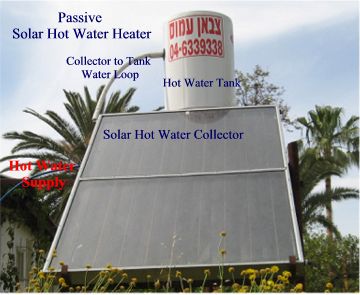|
The Passive Solar Water HeaterThe passive solar water heater is the simplest and cheapest solar water heating system. Find out whether you can install a passive solar water system where you live. Find useful installation tips and data on the expected cost, available tax credits, available loans and the expected Return on Investment period 
A passive solar water heater is a direct system.(By direct I mean water is used exclusively, with no resort to anti freeze fluid, heat exchange and other components). It is the simplest solar hot water heater. It is called passive because no external energy is required to circulate the water between the water storage tank and the solar collector. If one adds to it a solar hot water pump and a differential temperature sensor, one will end up with a direct active system. This will allows (adding a little to the cost) to install the collector higher than the tank (typical situation - the collector is on a slant roof and the tank is horizontally installed in the attic) Can you consider passive solar water heating system for where you live?Yes, under the following conditions:
If all three conditions apply to your specific location, passive solar water heater is your best choice The Passive Solar Water Heater system has two components, the solar hot water collector and the solar hot water tank.. Plumbing and running pipes is a straight forward proposition. Top consideration (if you did not add a pump) – the storage tank must be installed above the collector. Make sure to place the collector in an area that is not shaded. Installing on the roof (whether flat roof or slanted roof) is the most popular choice. However you can consider a non shaded area in the garden. The optimum orientation of the collector face is toward South, it can be compromised though. South East orientation or even East orientation will usually provide satisfactory results. The solar collector is slanted relative to the horizon to capture more sun radiation. On a slanted roof, the collector is installed parallel and close to the roof surface. It might deviate from the optimum theoretical slant angle, in practice you won't loose much in performance. The Solar Hot Water TankThe solar hot water tank is usually bigger than the conventional heater storage tank. Usually, it is installed outdoor, higher than the collector. The tank usually has inside it a backup electrical heater for cloudy days. (I mean real cloudy, even 2 to 3 hours of partial sun shine are enough to heat up the water.) The tank usually has over pressure protection and a thermostat that cuts the circulation to the collector (over heat protection) for collector and tank sizing click here Water Pipes and plumbing Overall, 4 pipes are connected to the system. In case you expect rare freezing conditions, e.g. over night, a work around is to arrange a valve in the collector that drains the loop water slowly just before the water temperature reaches the freezing point. Water bellow the freezing temperature might damage the pipes inside the collector; I prefer to use an indirect solar water heater system, a system that uses antifreeze liquid (such as glycol) in a close loop between the collector and the tank and a heat exchange to transfer the heat to the water.
Cost ConsiderationsTypical cost of a Passive Solar Water Heater kit can run between $2000 to 3000$ for a family of 2-3 people and up to $3500 for family of 4-6 people. On that you need to add installation cost. If a pump is needed, consider added cost of $200 to $400. You can be allowed tax credits from the IRS as well as some of the states Assuming tax credits the heating water system can pay itself in 3-4 years, click here to return to types of solar heaters types click here to return to Home Page from passive solar water heater page
|
This site for sale, affordable price
click to contact me for details

click to search the content on this site







